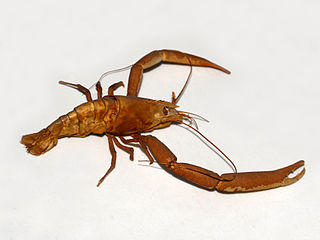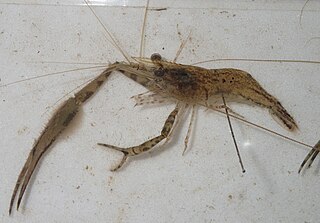
A freshwater prawn farm is an aquaculture business designed to raise and produce freshwater prawns or shrimp for human consumption. Freshwater prawn farming shares many characteristics with, and many of the same problems as, marine shrimp farming. Unique problems are introduced by the developmental life cycle of the main species.

Macrobrachium rosenbergii, also known as the giant river prawn or giant freshwater prawn, is a commercially important species of palaemonid freshwater prawn. It is found throughout the tropical and subtropical areas of the Indo-Pacific region, from India to Southeast Asia and Northern Australia. The giant freshwater prawn has also been introduced to parts of Africa, Thailand, China, Japan, New Zealand, the Americas, and the Caribbean. It is one of the biggest freshwater prawns in the world, and is widely cultivated in several countries for food. While M. rosenbergii is considered a freshwater species, the larval stage of the animal depends on brackish water. Once the individual shrimp has grown beyond the planktonic stage and becomes a juvenile, it lives entirely in fresh water.
Freshwater shrimp is shrimp which lives in fresh water.
Aquaculture in Vanuatu exists on a small scale, both commercially and privately. Several aquacultural efforts have been made in the country, including attempts to raise Pacific oyster, rabbitfish, Malaysian prawn, and tilapia. Experiments with Kappaphycus alvarezii and three species of giant clam were carried out by the Fisheries Department in 1999. The official Fisheries Department records state that $1165 US of cultured coral was exported from the country in 2000, with 275 pieces in total. The cultivation of Macrobrachium lar in taro terraces is practiced for subsistence purposes, and Macrobrachium rosenbergii has been identified by the Vanuatu government as a high-priority species.
Macrobrachium agwi is a species of freshwater shrimp, first described in 2008, endemic to the Himalaya. It was discovered when a shipment of ornamental prawns, destined for the aquarium trade, was shipped from Cooch Behar, West Bengal, India to Europe. Examination of the shipment showed that one type of shrimp was a new, undescribed species.

Macrobrachium ohione, commonly known as the Ohio shrimp, Ohio river shrimp or Ohio river prawn, is a species of freshwater shrimp found in rivers throughout the Gulf of Mexico and Atlantic Ocean drainage basins of North America. It is the best-known of all North American freshwater shrimp, and is commonly used as bait for commercial fishing, especially catfish.

Macrobrachium is a genus of freshwater prawns or shrimps characterised by the extreme enlargement of the second pair of pereiopods, at least in the male.
Syngnathus macrobrachium is a species of pipefishes, which is common in the southern-eastern Pacific in the coastal waters from Tumbes (Peru) to Puerto Montt (Chile). It is a marine subtropical demersal fish, up to 22.5 centimetres (8.9 in) length. Very little is known about this species' biology but it is thought that it lives over sand and other soft sea beds in shallow coastal waters including estuaries and brackish lagoons. This species is ovoviviparous, the males brood the fertilised eggs below the tail before giving birth to the larvae.

Macrobrachium carcinus is a species of freshwater shrimp known as the big claw river shrimp. It is native to streams, rivers and creeks from Florida to southern Brazil. It is the largest known species of Neotropical freshwater prawn, growing up to 30 centimetres (12 in) long and weighing as much as 850 grams (30 oz), although even larger specimens have been reported. It is an important species for commercial fishing in the Sao Francisco area, where it is known by the local name of pitu. M. carcinus is omnivorous, with a diet consisting of molluscs, small fish, algae, leaf litter and insects.

Macrobrachium formosense, the crane river prawn, is a species of freshwater shrimp in the family Palaemonidae. It lives in streams and rivers in Taiwan and southern Japan, including the Ryukyu Islands. Macrobrachium formosense reaches a carapace length of 10–20 millimetres (0.4–0.8 in).

Macrobrachium assamense is a species of freshwater shrimp that was first described in 1958. M. assamense is light brown to dark brown and found in Asia.

Macrobrachium hancocki is a species of freshwater shrimp found from Costa Rica southwards to Colombia and on Cocos Island and the Galápagos Islands. The species primarily inhabits swamp waters, small streams and stagnant pools. This species was first described in 1958.

Macrobrachium lamarrei commonly known as the Indian whisker shrimp, kuncho river prawn is a nocturnal species of freshwater shrimp found Biratnagar, Nepal.

Macrobrachium lar is a species of freshwater shrimp found throughout the Indo-West Pacific area, ranging from East Africa through to the Marquesas Islands and was first described in 1798. This species is found in flowing rivers and creeks near sea level.

Macrobrachium nipponense is a species of freshwater shrimp found in Asia that was first described in 1849.
Macrobrachium vollenhoveni, the African river prawn, is a species of large, commercially important prawn from the family Palaemonidae from West Africa. It is a catadromous species that moves from freshwater to brackish water to spawn returning to freshwater as larvae. Recent research has shown that it could potentially be used as a biological control to reduce the rates of infection people living near rivers where this species occurs with schistosomiasis.

Macrobrachium grandimanus, also called Hawaiian river shrimp or ʻopae ʻoeahaʻa in Hawaiian, is a species of shrimp. It has an amphidromous life cycle and is endemic to the Hawaiʻi islands.











